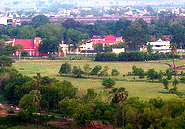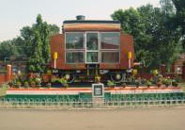Welcome to Jamalpur the world’s most beautiful place! Munger, Bihar
Welcome to Jamalpur ||Munger, BiharArchive for Railway
Improve Railways’ coal delivery for better returns
A mechanical engineer from the Indian Railway Institute of Mechanical & Electrical Engineering, Jamalpur (Bihar), Mr Kumar joined the Indian Railways in 1976 and took over as General Manager of the SECR November.
South Eastern Railway’s (SER) erstwhile Bilaspur Division, then the country’s largest freight-loading railway division, became the headquarters of a new zonal railway, South East Central Railway (SECR), on April 1, 2003, following trifurcation of the SER.
Today, the SECR is the single largest freight-loading (read, coal loading) zone of the Indian Railways.
In 2011-12, SECR handled 150.7 million tonnes (mt) of traffic, including 112 mt of coal.
Targets
The targets for the current year have been set at 158 mt and 118 mt respectively.
The targets, though achievable, are not without challenges, Mr Arunendra Kumar, General Manager of SECR, tells Business Line, drawing attention to a 0.4 mt drop in coal throughput in the first quarter vis-à-vis the same period of last year.
A mechanical engineer from the Indian Railway Institute of Mechanical & Electrical Engineering, Jamalpur (Bihar), Mr Kumar joined the Indian Railways in 1976 and took over as General Manager of the SECR November.
The SECR has embarked on a multi-pronged strategy to boost loading.
The strategy, according to Mr Kumar, presupposes having new private sidings to load more raw as well as washed coal, helping public sector coal companies tackle railway problems, launching new projects, speeding up implementation of projects on hand and upgrading the delivery system.
No rake shortage
Mr Kumar makes it clear that his railway does not suffer from a shortage of rakes.
“As many as 90 rakes are available every day for coal loading, with at least 25 per cent of them idling,” he says, asking, “Where is coal?” As he points out, out of the nine sidings of Mahanadi Coalfields in Ib Valley served by the SECR, only one has two-and-a-half days’ stock while others are living virtually hand-to-mouth.
In April, there was no coal for loading due to various reasons, including the dispute over payments between the washeries and their customers.
The SECR, though accounting for 72 per cent of total coal loading in areas served by it, is not connected to many pitheads directly and the rake loading in respect of these mines has to be supported by road-bridging, which is not the responsibility of the railways.
Overall, loading by coal companies has been unsatisfactory.
The coal companies hardly bother to properly maintain their own rail networks. They outsource the job with predictable consequences.
Derailments
Derailment is a regular feature and one derailment cripples movement for several hours. Last year, about 85 derailments hit the SECR’s coal movement.
“SECR, therefore, is assisting the coal companies concerned to upgrade their railway systems.
“A beginning has been made with the renovation of a 3-km-long railway line at Odisha’s Brojorajnagar under Mahanadi Coalfields Ltd at a cost of Rs 5.6 crore and a similar exercise is likely soon at Korba (Chhattisgarh) under South East Central Coalfields Ltd.
“We want coal companies to deploy more pay-loaders as it is possible to complete loading a rake of 59 wagons in two to two-and-a-half hours as against four to five hours at present by deploying five pay-loaders and thus achieving a 50 per cent jump in efficiency.
“Assuming such an improvement is difficult to sustain throughout the year, partial success yielding at least a 25 per cent improvement too will mean a lot. But then, deployment of pay-loaders is a contractual matter between coal companies and equipment suppliers.”
New projects
As for new projects, the Chhattisgarh Government has identified three railway corridors mainly to facilitate coal loading (with limited passenger services) and is serious about their early implementation.
Two of these projects, namely, the 85-km long Eastern Corridor between Bhupdeopur and Khargoda and the 122-km-long East West Corridor between Korba and Pendra Road, are receiving top priority with several rounds of discussion already held between the Chairman of the Railway Board (Indian Railways will hold 26 per cent equity stake in the special purpose vehicle to be formed to implement the projects), the Union Coal Secretary, the Chairman of Coal India Ltd and the Chief Minister, Dr Raman Singh.
land acquisition
However, land acquisition remains a big issue and, precisely for this reason, the extent of equity participation by the State Government, the coal company (most probably South East Central Coalfields Ltd, a subsidiary of Coal India) and even private firms, the prospective beneficiaries of the projects, are yet to be finalised.
The State Government’s participation will be by way of making land available.
The two major projects in hand include construction of a third line over a 485-km stretch between Jharsuguda and Gondia and a second line, over 42-km-long, on the 150-km Bilaspur-Katni line, also known as the CIC line.
Resources
There has been a delay in implementing the projects. Resource is a major constraint but there are other problems.
For example, the work on the CIC line was held up for more than two years due to the delay in getting a forest clearance.
“Also, it is not easy to undertake new construction alongside the existing lines on which normal movement has to be maintained with the number of trains increasing every year,” he says.
The delivery system improvement is sought to be achieved in several ways, namely, easing the gradients in certain sections (with five such sections having been identified and work on a pilot project near Nagpur already started), breaking long sections into two by signaling improvement (known as IBH, or intermediate block hut), and introducing more long-haul trains, that is, clubbing two freight trains into one that comprises 118 wagons.
Long-haul trains
Right now, the SECR operates 10 such long-haul trains, mostly empties, on the Bhilai-Korba route. The plan is to club three rakes into one for operation on the same route.
“We have problems, the most important being the capacity constraint, but we must find ways to overcome them and, if necessary, relocate resources to projects yielding better returns faster,” Mr Kumar observes.
Source: http://www.thehindubusinessline.com/industry-and-economy/logistics/article3669923.ece
Jewel of the East India Railway

Whenever I have debarked at the Jamalpur station from Howrah,I have felt like brushing out the cobweb of memories,somehow playing the tune of “The Swami”(If I guessed right!!) in my mind so a kaleidoscope of images hit my senses and pineal subconsciousness.
Once you are out of the station ,one sees some of the biggest rickshaws (with some seats slipping out) ,an erstwhile product of the the Raj (beckoning at you with those quaint rubber horns) jostling for space with the trekkers going to Monghyr, Buses going to Kiul and other places in a 30 kilometer vicinity and yes probably that one bus (Kumar Bhai).
A rickshaw will charge roughly 10-15 rupees to most of the places but still bargain.It is worth it as in other places across the orient and beyond!!Moving forward you will find the oldest tailoring shop in Jamalpur(Dressco) run by a centurion an easy six footer ,with dark eyes and a mehndi beard extending up to his chest….!!
When I was in school when I did not know about hair dye I thought he got the beard colored by chewing on a lot of betel and it was practically dried betel juice!!No offence but that was me then…
Move forward and you hit the tea shops in a row .If you went inside you could hear snitches of what went on in the darker sides of Jamalpur but they made an excellent glass of lemon tea…!!
The biggest landmark this side of Jamalpur is the Jubilee Well, …Yes!! There is a pucca well in the middle of the road and it is a fork from where the left one went to Monghyr and the other went to the Railway Colony of the sahibs!
Once on the railway bridge you get an idea of the expanse of Jamalpur!!The white building you see at 11 O Clock with a NtD on top is Notre Dame Academy.But that is another epic story I guess!!
If you went to Jamalpur ,you had be pleasantly surprised to see all the roads named after the British Royalty .So now once you are coming down on the other side of the railway bridge(Badi Pool) on the left you will see once of those structures resembling world war II hangars .It is the cinema hall called the National Institute catering to the natives who came for the movies ,some cards,a small library but most of the times just to loiter,chat and stretch after a day;s toil at the Railway workshop.
O ….I do have stories for this place as well…just wait …but that is another generation ,once that came to Jamalpur in the 50s and 60s for season change,love ,a job and not necessarily in that order.
So now you see the Albert Road on the left after the National Institute ,you have the austere Notre Dame School building rising out and then the post office in front and the I.W(Inspector of Works) office in the right.
So now let me take the second longest road in Jamalpur.The ALBERT Road
As you pass the school on the right and the Jamalpur Municipalilty office on the left,what you will love is the defunct steam roller on which some generations of Notre Dame guys have played. Another relic from the Raj days may be….at least I like to romanticize that way.Move forward to find the East Colony Bank.Even though it is now shifted to the first floor the tea shop beside it of Jadav ji is a place you cannot miss. Dark,dingy,old world….that’s it!!His son Raju now has grey stubbles so what.Behind them is an entrance to th Notre Dame schoold dispensary and post that you have a saloon, Priya Studio,a liquor shop(may be it is no longer there) , an old ration shop with stairs winding up to no where and a big banyan tree.
Take a right and you will be on the workshop road but i will stick to my road.The next stop is Hira Mode.There used to be a hira’s hotel which used to supply the brown sahibs with jalebis anmd sweet meats.The last i saw it smelt of dank sweat,burnt wood,two mangy dogs ,a dry tube well and an old man sleeping ….Just beside it you have the star hotel of Jamalpur the erstwhile Madras Coffee House .They used to sell only idli dosas but now they have some accommodation rooms as well .
More to continues…
http://gaiapriest.blogspot.com/2009/09/jewel-of-east-india-railway.html















